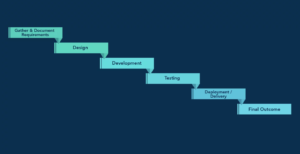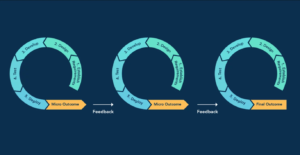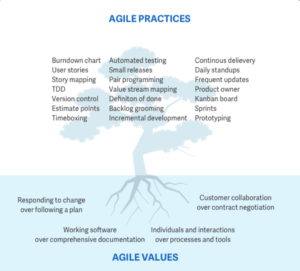Top 10 Business Trends to Watch for in 2022
By Andrea Brockmeier, Jason Cassidy, Susan Heidorn, Jose Marcial Portilla, and Mike Stuedemann
While 2021 has been better in many ways than 2020, it doesn’t feel much more predictable. Yet, at Educate 360 we have identified some the biggest trends we are seeing and expect organizations to continue experiencing in Project Management, Business Analysis, Agile, Data Science, and Leadership in the year ahead.
Overall, the theme of working remotely comes through loud and clear and we expect it to impact almost every area that we covered.
Here are our Top 10 trends to watch for in 2022. We’d love to hear your thoughts about our observations and prognostications.
Project Management
Project Managers as Project Leaders
The recognition that project managers are both leaders and managers is not new, but the need for the leadership aspect of the role has intensified in the last couple of years and will continue to do so in 2022. In fact, we are hearing more organizations using the title project leader as opposed to project manager.
To be sure, the technical aspects of the job such as scheduling, budgeting, and tracking haven’t been eliminated, but the need for skills like influencing, facilitating, communicating and other “soft” skills associated with the PM as leader has become paramount. Project managers as leaders are going to continue to be challenged in 2022 with distributed teams and all the distractions of ever-changing global and work environments. Leading the team and engaging stakeholders to sustain buy-in is going to continue to be job one for effective PMs in 2022.
More Organizations Using Project Management Tools
In 2022, expect to see a continued increase in the use of project management tools beyond the standard Microsoft Office suite. We used to see only the occasional client using a PM application of any kind and it was almost always Microsoft Project. Whether because people are working remotely, tools have become more cost effective, or tools have become more accessible and easier to use, we see more organizations using PM-specific tools and we’re seeing a wider variety of tools, as well.
At first this may seem contradictory to the previous trend of project leadership getting emphasized over project management; tools are not generally used for the leadership aspects of the PM role. Perhaps these trends are mutually reinforcing in that tools like Asana, Wrike, Easy Project, Smartsheet and others help with project management which allows the PM to tend to the demands of project leadership. Whatever the reason, we look ahead to 2022 as a robust year for PM tool implementation.
Business Analysis
Strong Facilitation and Communication Skills for Remote Business Analysts
We have all have heard about the Great Resignation – employees leaving their jobs in record numbers in search of better pay and career opportunities, a healthier work-life balance, a less toxic working environment, and desire to continue to work remotely. As a result, many companies are reducing their carbon footprint as well as costs, so they either have smaller offices, holding a space for meetings or providing “hoteling” spaces when employees need or want to go into the office to work. Organizations are also realizing that they can hire talent around the globe.
So, what does this mean for business analysts? It means we must get better at communicating and facilitating in a virtual environment. We must learn how to build trust when we can’t directly “see” stakeholders daily. We must be able to facilitate virtually to ensure we elicit inclusive requirements and not just those from a few vocal stakeholders. We need to learn to creatively collaborate with our team members, colleagues, and key stakeholders to ensure we have their buy-in.
BAs need to think about communicating and facilitating with more intention. This calls for mindful facilitation as opposed to simply the ability to use Microsoft Teams, Slack, or other communication platforms. We are already starting to see – and we continue to see in 2022 – more BAs focus on learning how to create safe, trust-laden, and collaborative environments within which stakeholders readily share information in a world that has been changed forever.
Digital Transformation Strategy Supported by Business Analysis
Digital transformation has been a trend for some years, and it is still going full steam ahead. Yet, most of these efforts fail. There are many reasons cited for this failure; among the most common include:
- NOT understanding the business problem, but instead just throwing solutions or technology at the wall to see what sticks.
- NOT determining success criteria so organizations have no way of knowing if the initiative has been successful because there was not a shared understanding of what success looked like.
- NOT realizing that digital transformation introduces cultural changes in the organization (which is also one of the reasons many organizations had difficulty adopting agile).
Because of these failures, organizations moving toward digital transformation will rely more on business analysis capabilities to effectively address root causes of the problems above. BAs will be used on digital transformation initiatives to ensure the business problem or opportunity has been fully analyzed and understood, to verify that the organization is ready to adopt the new culture, and to identify overall success measures as well as identifying smaller, incremental success measures that can be measured throughout the project.
These efforts will also require a business analyst’s in-depth knowledge of agile business analysis approaches, tools, and techniques that will be critical as organizations strive to become more agile in their ability to respond to customers and competitors. Look for lots of opportunities in 2022 for BAs to plug in as key strategic resources on digital transformations.
Agile
Teams Continue to be Distributed – By Choice, Not Necessity
It can be argued that the COVID 19 pandemic did more to transform the world of work than any document, framework, certification approach or technology. One of the lasting impacts of the pandemic is that distributed teams are here to stay. Product development team members and their leaders will need to permanently adjust to working in a distributed fashion.
While many still share the perception that all Agile frameworks require co-located teams (see principle 6 associated with the Agile Manifesto), technology has advanced to the point where a team adopting a framework doesn’t need to all be in the same location. Continued discipline, particularly in the area of communication and team working together agreements, will be required as teams shift from distributed work by necessity to distributed work by choice.
Scaling – Addition by Addition or Addition by Subtraction?
The marketplace continues to see the emergence and growth of a number of Agile scaling frameworks. The Scaled Agile Framework (SAFe), Large Scale Scrum (LeSS), Scrum at Scale (S@S) and Disciplined Agile Delivery (DAD) are just a few of the prominent entries in this space. Next year will see organizations continue to adopt these frameworks as they seek to realize the benefits of being more responsive to change at a global level.
Current thoughts are mixed regarding how to achieve this goal. While many of the current frameworks (e.g., SAFe) advocate adding structure and layers, some like LeSS believe that true organizational agility can only be achieved by removing items from the organization that don’t directly contribute to the delivery of customer value. This debate is even more nuanced when the idea that some additional structure might be necessary on a temporary basis while the organization is being transformed. In 2022, we expect to see continued debate as to what steps are actually necessary to achieve agility on a global scale.
Agile Outside of Software
The Agile movement was born in the software development space. After all, it is called the “Manifesto for Agile Software Development”. In recent years, other domains have adopted a number of the values and principles that define the Agile movement in attempt to accrue its benefits. For example, there is currently an Agile Marketing Manifesto as well as efforts to bring an Agile mindset and some of its practices into education.
This trend will accelerate in 2022 as events such as the pandemic, natural disaster, and political and economic shifts remind organizations that the only constant is change.
Data Science
Increasing Application of Artificial Intelligence and Reinforcement Learning
We often hear that Artificial Intelligence is one of the trends that will change the world. This past year certainly validates that sentiment, and 2022 will continue to see evidence of this powerful trend.
But what is actually meant by the term “Artificial Intelligence”? Technically speaking, AI systems typically incorporate a special type of machine learning known as “Reinforcement Learning.” These specialized programs allow a computer to learn the same way a human does, through experience with trial and error.
In 2016, DeepMind (an Alphabet company) made headlines when its computer program AlphaGo beat the world’s best Go player, a feat many previously thought was impossible. The AlphaGo program worked through Reinforcement Learning methods, where the computer played thousands of games against itself, learning the best tactics to win the game of Go.
Fortunately, Reinforcement Learning has applications beyond just board games. In 2021, DeepMind released AlphaFold 2, a computer AI program that can accurately predict protein folding structures, opening up new possibilities in drug discovery and medicine.
The application of AI and reinforcement learning will definitely be a trend to keep an eye on, as the progress has increased exponentially.
Huge Strides to Continue with Natural Language Processing
Natural Language Processing (NLP) is the use of machine learning models to interpret raw text data, such as Wikipedia articles or even code written by humans. Traditionally, NLP technology has been used for classifying text articles into categories or sentiment analysis of reviews. By simply training NLP models on existing text data sets, the models can learn the topic of a new article, or whether a movie review is positive or negative.
Huge strides have recently been made in the capabilities of upcoming NLP technology. In 2020, OpenAI released “Generative Pre-trained Transformed 3,” commonly known as GPT-3, which has the ability to generate text that is nearly indistinguishable from that written by a human. GPT-3 was trained on hundreds of billions of words that were scraped from the internet and is even capable of coding in CSS, JSX, Python, among others.
In 2021, OpenAI further expanded on the idea of an NLP model that can code, by releasing Codex and Github Copilot. These futuristic state-of-the-art models can not only automatically complete large portions of code, but they can also accept a description of what the code should do and produce the corresponding code. Check out this Codex demo launch video.
The future is already here! We are definitely looking for exciting new applications of NLP continue to make headlines in 2022.
Leadership
Attracting & Retaining Talent – But Different Than Before
Attracting and retaining talent is the most prominent topic of conversation we’ve observed in media related to leadership, specifically attracting and retaining talent in a COVID-changed environment. It’s not clear anyone has permanently figured out the solution as the situation is still in flux, so we have listed key points that we hear leaders weighing in with in their decisions related to remote work and its implications for finding quality team members.
Let’s start by making a broad assumption (that certainly can still be refuted) that some jobs cannot be done remotely (e.g., printing and shipping) and some jobs potentially can be done remotely. Below are the key topics of debate that will continue to shape this discussion in 2022:
- Job Equity: Is it fair to the people whose roles cannot be done remotely and who have to come into the workplace that others can work at home? As this question is discussed topics related to safety, expenses, commute time, flexibility, teamwork, fairness all come into play.
- Productivity: Even if jobs can be done remotely, what is the level of productivity of remote work versus work in the office? As this question is discussed one hears that people work longer hours at home because they are not commuting, that people are more productive at home because they can focus and not be disturbed. On the other hand, you hear others say that people are less productive at home because they are distracted by non-work items and that people are less productive at home because they are not being watched. You also hear discussion of managers’ ability to manage in-person versus remote team members.
- Cultural Impact: Even if a job can be done at home, is it better for the organizational culture? As this question is discussed topics related to collaboration, mentoring, camaraderie, organic problem solving and innovation, and work-life balance come into play.
These debates and questions will dominate leadership conversations in the coming year as leaders continue the challenge of finding and hanging on to top talent.
Jason Cassidy, PMP, is CEO of Educate 360, the parent company of Project Management Academy, Watermark Learning, and Pierian Data. – training partners of choice helping organizations improve organizational efficiency and effectiveness, increase cross-functional alignment, and drive results to help meet and exceed business performance goals.
Andrea Brockmeier, PMP, is Director of Project Management at Watermark Learning, an Educate 360 partner company. Dr. Susan Heidorn, PMP, CBAP, BRMP is Director of Business Solutions at Watermark Learning. Jose Marcel Portilla is Head of Data Science at Pierian Data Inc., an Educate 360 partner. Mike Stuedemann, PMP, CST, is a Scrum-Focused, Agile Agnostic Coach and Trainer at AgilityIRL and partners with Watermark Learning for Scrum courses.










